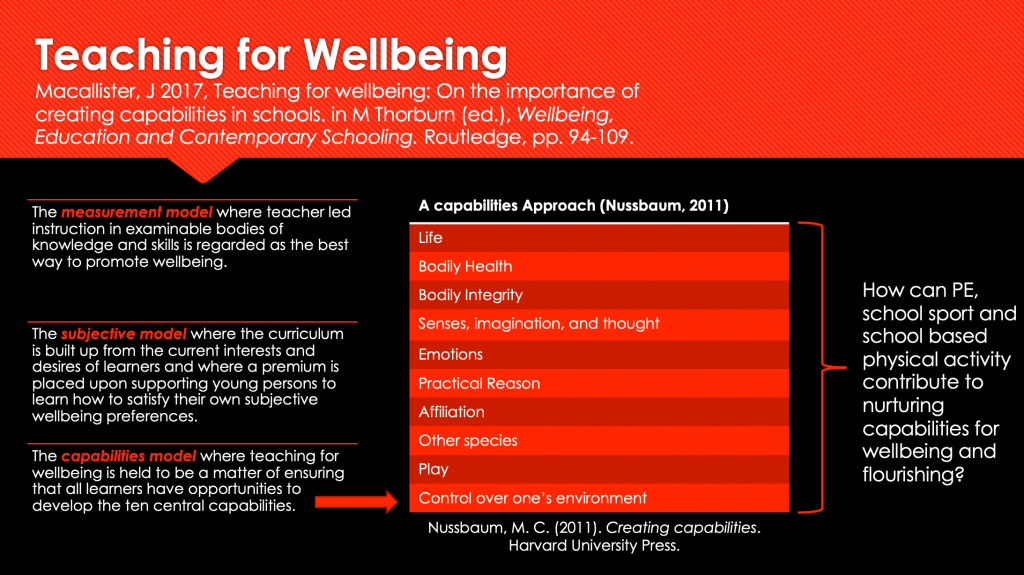
The view we have of children shapes what type of PE, school sport and school based physical activity (PESA) we provide. In a deficit based approach we see children as either at risk of becoming broken or already broken. We see their bodies, their movement and their character as something that requires fixing, and that through PESA we can achieve that. We focus on what they don’t do and what they can’t do. A strength based approach sees the children we teach as already having assets, capabilities and resources. It is one of the 5 propositions that currently underpin the Australian Health and PE curriculum and it is something we should seriously consider in England. As Karen Lambert and Justen O’Connor state a strength based approach is about ‘flipping the rhetoric’ to what they can do and what they are striving to achieve and that we should rid ourselves of this deficit model altogether. This would change our thoughts, our language and ultimately why we offer PESA, how we offer it and how it is experienced.
A strengths based approach to health
A pathogenic view of health is deficit based and sees us in one of two states – diseased (or not normal) or healthy (normal). This perspective focuses on the prevention of disease and illness, with PESA’s task about helping children to understand, overcome and avoid them. PESA that focuses on highlighting the risks and deficits is a narrow view of learning about what health is. A salutogenic perspective (strength based) offers a dynamic notion of health, and one that may be more suitable to the educative aims of PESA. Health becomes about our response to the type of life we want to live and how we want to live it. Being healthy means being able to live a good life with ease rather than with difficulty.
Mikael Quennestedt suggests this salutogenic notion of health changes the type of questions we ask about it. Questions about avoidance behaviours such as “How do we use physical activity to prevent obesity, future diseases and premature death?” transform into questions about growth such as “How do we use physical activity to strengthen people’s health resources?”
A strength based approach to wellbeing
Wellbeing as an educational aim of PESA is growing in its support and advocacy. However this can only happen if PE Teachers (and schools) are clear about the sort of wellbeing they wish to achieve. James MacAllister highlights a distinction between pseudo wellbeing and real wellbeing, with the pseudo type offering activities and designing curriculums which might contribute and satisfy the children’s own subjective wellbeing preferences. Real wellbeing is a strength based approach, ensuring all children develop capabilities so they can act in ways that aid their own wellbeing and others. He draws upon Martha Nussbaum’s capabilities approach, where capabilities are ‘what this person is able to do and be‘. There are 10 capabilities (which appear in the graphic above) and PESA is well placed to support the development a significant proportion of them. A capabilities approach to teaching wellbeing in PESA will require teachers to help children to support each other in caring ways and to work out what is a good life.
A strength based approach to conversations
When observing children who are participating in PESA do you wear glasses with deficit based lenses or strength based ones? Which one you wear influences what you look for and how you then engage with the children. When we wear our deficit lenses we are scanning for things that are wrong, and we rectify them by pointing it out and telling children what to do better. We solve their issues for them.
Stephen Rollick and colleagues in their book on motivation interviewing recommend that we need to overcome this ‘righting reflex‘ and wear our strength based lenses. This doesn’t mean we ignore issues, but rather we notice and use the children’s strengths in an attempt to address them. This leads to a change in mindset from ‘I have all the answers to your problems‘ to ‘what do you think the problem is and how can we work together to solve it‘. The authors call this a change talk, as it’s about getting the child to think about the benefits of making a change, the ways in which they can make it happen and adapting our language to best support them to do this. To do that well we must connect with them, inquire about the best way forward, offer advice with choices and to develop action plans together.
Concluding thoughts…
The demand to fix is everywhere. It means we get trapped in the details and miss the bigger picture. We see the child in front of us as faulty object which we need to fix, rather than a complex human being with assets, capabilities and resources.
Therefore PESA is framed as a way of solving perceived deficits within children – even in the last few weeks on social media PESA has been positioned as the means of sorting out poor behaviour and getting children to focus for other lessons. It is also framed as fixing issues with health and wellbeing (a pathogenic view). Its focus is on minimising disease and illness, which is a narrow and impoverished view of health which lacks meaning for many. Rather we need to embrace what Corey Keyes calls the ‘salutogenic challenge‘ as by focusing on the outcomes of positive health we can better learn how to promote and protect good health. A strength based approach in PESA doesn’t mean turning a blind eye to problems, but about what we look to first highlight and prioritise.
When I and others reflect on what drove our involvement in PESA in childhood it was never about overcoming deficits. I didn’t get up every Saturday to play rugby because I thought it would improve my blood pressure, my weight or my resilience. I didn’t engage in sport because of all the perceived deficits I saw in myself. It was and still is about building strengths & providing positive experiences that enrich my life. My engagement in rugby was fundamentally about the feeling of belonging and affiliation. Now as an adult, whilst health concerns are more on my mind, it is still not the main motivational driver for why I continue to a place for movement in my life.
A crucial point of taking a strength based approach is that we must get to know our students – what their needs are, what their strengths are and what their interests are. To do that we need to facilitate better meaningful dialogue and reflection about how forms of movement could support a life worth living. Who do you want to be? What do you want to do? What do you think is a good and meaningful life? How could movement support this and enrich the quality of your life? These are challenging but important questions to ask and reflect upon. To do this PESA needs to focus on on developing strengths, capabilities and promoting positives which can make a distinctive contribution to our children’s wider flourishing.


One thought on “A strength based approach to PESA”